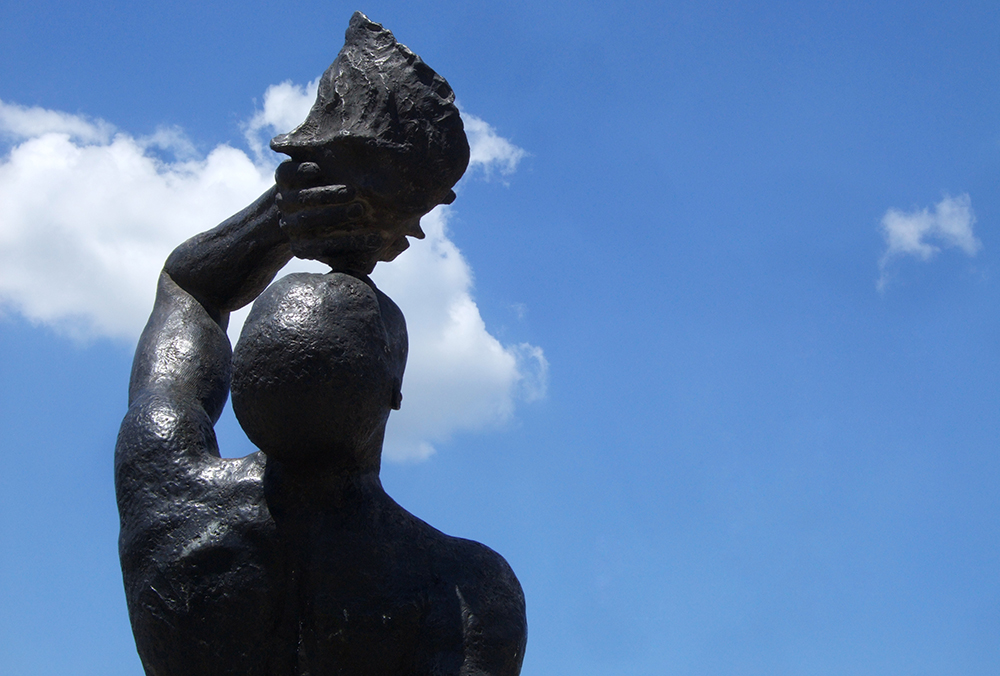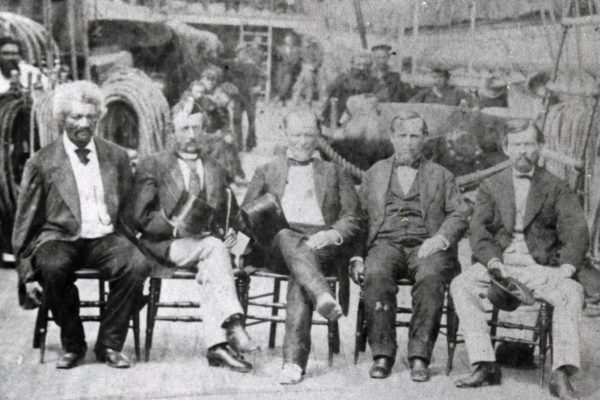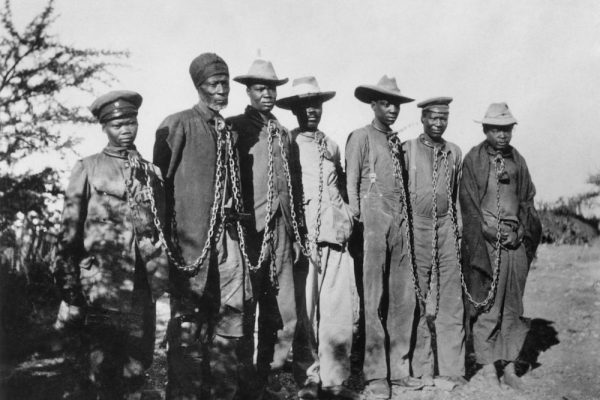The Common Wind: Afro-American Currents in the Age of the Haitian Revolution
Julius S. Scott
Verso, $24.95 (paper)
Tacky’s Revolt: The Story of an Atlantic Slave War
Vincent Brown
Belknap Press, 2020, $35 (cloth)
The Bloody Flag: Mutiny in the Age of Atlantic Revolution
Niklas Frykman
University of California Press, $32.95 (cloth)
The Age of Revolution (1770–1850), bookended by the American and French Revolutions on the one side and the Revolutions of 1848 on the other, is widely viewed as the progenitor of the modern Euro-Atlantic world. Its intellectual energy fused the liberal and republican ideas of John Locke with the ideals of the eighteenth-century Enlightenment; its political energy fed off the struggles between the bourgeois and their aristocratic enemies. Although visionary hopes could meet crushing defeats—as they did during the popular risings of 1848—by the end, there were new parliamentary regimes, emerging nation-states, declarations of rights, and the eruption of an industrial age.
And yet, this classic narrative leaves out the most radical of the revolutions that exploded neither in continental Europe nor in North or South America, but in the Caribbean, on the island the French called Saint-Domingue and the victorious rebels would call Haiti (Ayiti), after its indigenous name.
Until recently, the Haitian Revolution and other Caribbean slave rebellions have been treated as sidebars to the Age of Revolution. In part this is because of a Eurocentrism that has long diminished the role of Black people in shaping history. But equally important, enslaved people didn’t fit an accepted image of political actors, and thus it was difficult for historians to see them standing alongside the signers of the Declaration of Independence in America, the Jacobins in France, the Bolivareans in Gran Colombia, the Mazzinians in Italy, or the Chartists in England: envisioning, allying, struggling, surmounting. This, despite such works as C.L.R. James’s Black Jacobins: Toussaint L’Ouverture and the San Domingo Revolution and W.E.B. DuBois’s Black Reconstruction in America, 1860-1880, which left little doubt about the political capacities of enslaved Blacks.
Nowadays, Eurocentrism is called out for its parochialism as well as its veiled racism. Historians are much more attentive to questions of empire and colonialism, so they place the events of the Age of Revolution in a much broader context. Circum-Atlantic and transnational histories abound and have exerted enormous influence on eighteenth- and early nineteenth-century studies. The Haitian Revolution has itself been the subject of a rapidly growing scholarship, whether looking from the Caribbean out or from the Euro-Atlantic in. And there has been renewed interest in slave systems, the maritime world, and their relation to the development of capitalism.
Still, it is not entirely clear how the pieces of this newly expansive story come together: how we may reimagine and reconceptualize what the Age of Revolution would look like if viewed comprehensively from below and from above, if portrayed with a much larger array of political actors and a much greater sense of the scope and ambitions of international as well as local politics. And if understood as coinciding with—indeed, deeply interconnected to—an age of emancipation in which the most powerful slave regimes in the world were overthrown despite hesitation among Euro-American revolutionaries themselves. The three outstanding volumes under review here offer the materials for just such a reconsideration.
The Common Wind (its title taken from William Wordsworth’s ode to Toussaint Louverture) is a pioneering contribution to our understanding of the place of Haiti in the Age of Revolutions. A revised version of Julius Scott’s 1986 doctoral dissertation (its publication delayed by unexpected circumstances and a determination to get the story right), the book is less about the Haitian Revolution per se than about the circulation of ideas and experiences that both lit the fuse and then sent the explosive results across an immense space. Indeed, Scott’s is a multinational history that suggests how the revolutionary years from 1780 to 1815 might appear if Saint-Domingue and then Haiti were recognized as a hub around which the politics of the period radiated.
Arguing that the commodity-producing slaveocracies of the Caribbean were major sites of trade and migration, Scott draws our attention to the ports rather than the plantations, to the seas rather than the land, and to the “masterless”—sailors, free people of color, runaways, maroons—as much as to the enslaved. They are the keys to understanding how news, rumors, information, and ideas flowed across the Atlantic and around the Caribbean: the ever-thickening veins of commerce that linked Nantes and Bordeaux to Cap-Français (now Cap-Haïtien), Port-au-Prince, Havana, and Kingston. These trade routes brought thousands of vessels and maritime laborers into the harbors of all of these cities; they also brought fugitives and veterans of battle. Two of eighteenth-century Saint-Domingue’s rebel leaders (Makandal and Boukman) fled there from Jamaica. Henri-Christophe, another leader, was born in St. Kitts. He, Andres Rigaud, and Martial Besse, free men of color who became military leaders, served with the French forces at Savannah during the American Revolution.
As a result, the enslaved and the free people of color in any one place learned of history’s unfolding elsewhere and transformed the languages of revolution that they heard—and, in some cases, read—into their own political vernacular. The radicalism of the Age of Revolution, as Scott so brilliantly shows, was invigorated as it moved from France to Saint-Domingue and then to Jamaica, Cuba, and back. The visions of the Jacobin Republic in France and of the slave rebellion turning revolution in Saint-Domingue were both mutually constitutive and ever expanding.
Like a stone that falls into the water, the rebellion in Saint-Domingue, as Scott demonstrates, had ripple effects going in multiple directions: to other Caribbean islands, to the South American mainland, and, perhaps with greatest effect, to the United States. Beginning in 1793, thousands of slaveholding emigres, their slaves often in tow, headed out of Saint-Domingue to whatever port might offer a measure of safety. Well over 10,000 landed along the Atlantic and Gulf coasts of North America, settling in Philadelphia, Baltimore, Charleston, Savannah, Pensacola, Mobile, and especially New Orleans. With them came vital news of rebellion in Saint-Domingue that sent fear through the minds of American slaveholders and hope through the minds of their slaves, who quickly learned that the wealthiest and most powerful slave regime in the world had fallen before the might of their enslaved counterparts.
The consequences would be enormous for the social and political history of the Western Hemisphere and Euro-Atlantic and particularly for what was about to become the new center of the slaveholders’ world: the U.S. South. The rumblings from below were already apparent in the 1790s with slave conspiracies in Louisiana, and then, in the early nineteenth century, with the aborted Gabriel’s Uprising of 1800, the St. John the Baptist Parish revolt of 1811 in Louisiana, and the Denmark Vesey conspiracy of 1822 in Charleston, all of which showed either the direct influence of the emigres or secondhand knowledge of what had transpired in Saint-Domingue. As the cotton economy spread across the Deep South, the enslaved laborers who were driven along with it could now know that slave systems were not cast in stone and timeless, that they were vulnerable and could be destroyed by people like them. As we have come to realize, owing to Scott’s groundbreaking work, there is no way of understanding the history of the United States during the first six decades of the nineteenth century, and especially the emancipation process during the Civil War, without acknowledging the political shadow cast by the Haitian Revolution and the political roles played by previously unrecognized actors: the masterless of the Atlantic and the enslaved workers their enslavers thought they had mastered.
During the Haitian Revolution, the rebel armies under the command of Toussaint Louverture not only toppled the slaveholding class of Saint-Domingue; they also defeated the armies of Britain, Spain, and France to secure their victory, freedom, and eventual independence as the Republic of Haiti. Slave rebellions, together with the quotidian struggles in which enslaved people engaged, were nothing less than warfare. And although this might seem apparent on considered reflection, few scholars have taken to the idea and its meaning for the study of slave regimes. Vincent Brown is a notable exception. Slave warfare is one of the central conceptual points in Brown’s extraordinary book on Tacky’s revolt, the massive Jamaican slave rebellion of 1760–61. Indeed, Brown sees the rebellion as more than an episode of Jamaican history and internal warfare; he sees it as part of a multilayered set of wars that encompassed both sides of the Atlantic and involved empires in Africa and Europe. Combining meticulous research in a multitude of national archives and the use of new technologies for visualization, Brown has produced one of the best treatments of slavery ever written.
Enslavement, Brown reminds us, did not simply begin in West Africa and get redeployed in the Western Hemisphere. As a system it was in constant motion, embracing people and states on several continents, trade and commercial relations crisscrossing the Atlantic, and—notably in the eighteenth century—almost continuous warfare as well as brutal regimes of exploitation. Owing to Brown’s success at identifying many of the enslaved participants in the events he recounts, we are able to see how the rebellion in Jamaica was very much an extension of wars erupting in the West African interior, propelled in many cases by the demands of European trade, and involving Africans who went into battle in both places.
Jamaica was Britain’s most lucrative colony and its most formidable military base, a virtual “garrison government” devoted to keeping enslaved laborers in subjection, fierce maroons (fugitive slave communities) in check, and rival empires at bay. The sugar plantations, where half of the enslaved Africans toiled, often took on the appearance—in their architecture and placement—of fortifications, and the work regimens on them showed military-like cadences. Between a half and three-quarters of Jamaica’s slaves in the mid-eighteenth century were African born, often veterans of West African wars, and thus quite aware of the broad context in which their enslavement occurred. Many of them had been forced aboard slave ships along the Gold Coast and became known as Coromantees (perhaps from the English post at Cormantyn), though they had generally been taken captive much farther inland and belonged to a number of different ethnic and linguistic groups. The Coromantees had reputations for their strength, skills, discipline, and rebelliousness: they were simultaneously prized and feared by their enslavers.
With attentiveness to the multiple sources and contending narratives, Brown demonstrates that what the British would call “Tacky’s revolt” was only part—a small and abbreviated part—of a larger “Coromantee war” that engulfed Jamaica for months. Although it is difficult to uncover the scope, timing, and objectives of the plot, Tacky and fellow slaves from the Gold Coast rose in St. Mary’s Parish in early April 1760 and seemed most intent on wresting control of the nearby riverine commercial zones and Fort Haldane from which weapons could be taken (the book’s wonderfully detailed maps help us visualize the revolt’s course). Early success came undone in the face of the British militia and of the maroons who had signed a treaty with the British long before and were ready to fulfill their end of the bargain: secure slavery in return for their independence and autonomy. There were, that is, political fissures of great consequence within the African-descended population. Tacky, it appears, was killed by one of the maroon’s bullets, and his revolt collapsed in short order.
But this was by no means the end. There is some indication that Tacky and his followers—nearly half of whom may have been women—rose too early; that they were to have awaited the arrival of the Whitsun holidays some weeks later to coordinate island-wide. British colonial officials and the slaveholders took no chances; they stretched the trials and executions of the captured rebels out over several weeks to gain more information and set terrifying examples of punishments. It didn’t work. In late May another rising occurred in Westmoreland Parish, the heart of the sugar plantocracy, led in this case by Wager (his African name, Apongo), whose trans-Atlantic story Brown reveals in all its complexity and with imaginative guesswork. The Westmoreland rising did not collapse in short order, even when the British navy became involved (thus linking the Jamaican rising with the Seven Years War) or when Wager was captured and gruesomely executed that summer. Rebel bands continued their struggle into the following year, relying on tactics of guerilla warfare, before some semblance of order was restored. Altogether, the Coromantee war would rank as the largest slave rebellion in the Western Hemisphere before the Haitian Revolution. It formed a great peak in what Brown terms an “archipelago” of warfare that stretched from the Gold Coast of West Africa through the plantation zones of Jamaica, “at once an extension of the African conflicts that fed the slave trade, a race war among black slaves and white slaveholders, an imperial conquest, and an internal struggle between black people for control of territory and the establishment of a political legacy.”
The tsunamis of revolt and revolution in the second half of the eighteenth century were just that, because the seas were integral to the making and meaning of these convulsive events. The rebels in Jamaica and Saint-Domingue had made many journeys across the Atlantic and around the Caribbean. Their perspectives as to what was possible and how to struggle were informed by their fellow seafarers as well as by the masterless souls who manned the vessels of commerce and warfare and brought news—often embellished with their own interpretations—of political developments in London and Paris, along the Gold Coast and Bight of Benin, and in the ports of Barbados, St. Croix, Cuba, Demerara, and Berbice. And, as Niklas Frykman demonstrates in The Bloody Flag, the crews of the warships of Britain, France, and the Netherlands not only carried stories of multiple rebellions; they engaged in rebellion themselves and thereby expanded the dimensions of a revolutionary age.
The naval fleets of the eighteenth century may seem to pale in comparison to our own world of destroyers, aircraft carriers, and nuclear submarines, but the line-of-battle ships were easily the most powerful weapons of war during that time. They were also enormous sites of social hierarchy and labor exploitation. Building on the foundational studies of Marcus Rediker, Frykman reveals the many ways in which naval vessels were historical bridges between the plantation and the factory: in the hundreds of seamen (in some cases nearing a thousand) who labored in twenty-four-hour cycles; in the national, ethnic, and sometimes racial diversity to be found among them; in the brutal regimens and dangers of the work (a “barbaric industry”); in the surveillance to which the crews were subjected and the almost unlimited power of the ships’ officers; in the punishments that were meted out to those who defied the rules (chiefly flogging but also execution); in the form of resistance most common (running away); in the coercive practices (particularly impressment) that could be used to assemble an adequate crew; and in the demands for better and more equitable pay and treatment that could be raised. The term “strike” is of maritime origin. If nothing else, Frykman’s is a significant contribution to Atlantic labor history.
But much more is offered up. The distinction between a strike and a mutiny may be hazy and potentially shifting, as is true for all types of rebellion. Either form of protest could involve a few seamen or a great many, and could occur in a variety of circumstances and times. The 1790s, however, proved to be an especially turbulent era on the seas as it was on the land. There were, according to Frykman, more than 150 single-ship mutinies together with a half dozen fleet mutinies over the course of the decade; in 1797 alone, the British navy experienced mutinies on more than a hundred of the ships in its fleet involving an astonishing 40,000 men, likely the “largest, best organized, and most sustained working-class offensive in eighteenth century Britain.” Some, echoing the political aspirations of the age, proclaimed a “floating republic.”
Frykman’s is very much an account of class formation and political radicalization. And he recognizes them as closely interconnected and mutually reinforcing. On the one hand, he is attentive to the different national experiences to be found as to the makeup of the crews, the means of recruitment, the relationship between maritime and terrestrial (mostly urban) labor, and participation in the warfare of the 1790s. On the other hand, he demonstrates how a shared consciousness, international in its horizons and reflective of the revolutionary struggles in the Atlantic, developed and made itself felt: revolutionary maritime republicanism, Frykman suggests we term it.
By the early 1800s, the authoritarian paternalism that had long shaped relations between officers and seamen had given way to a new arena of struggle organized around class warfare, though one that never fully displaced the political allegiances of warfare between nations. It was “a deepening division of shipboard society into two sharply defined and opposing classes that found its most striking expression in the adoption of the red flag”—the bloody flag—“as a symbol of permanent struggle between them,” accelerated by global conflict and the intense solidarities fostered by maritime labor. Although the mutinous explosions of the 1790s would be quelled by iron fists of suppression, the fortitude of the crews and the coercive practices that they endured led to anti-impressment campaigns in the new United States, which played an important role in articulating the substance of American independence, as well as in Britain. Leaders of the British anti-impressment campaign, such as Granville Sharp, were already deeply involved in the abolition movement, suggesting how the seaborne struggles of the 1790s contributed both to the age of emancipation and the making of national and international working classes. Small wonder that class-conscious sailors would later rear their heads, to great effect, at Kronstadt, Sevastopol, and Kiel, influencing the course of the Russian Revolution and the collapse of the German Imperial state.
How may these works, distinctive in their own ways, together contribute to new perspectives on this revolutionary age? The Coromantee wars of 1760–61 fall outside the customary chronological markers, yet Vincent Brown suggests how we can rethink the placement of those markers as well as the political currents of the Age of Revolution itself. The wars, Brown writes, “represented a watershed in the course of Atlantic history. Regional political maps had been drawn by the wars that opened new territories for cultivation, stimulated the slave trade, and enhanced state power—but the slave rebellions etched another record of historical movement. They channeled people into new solidarities and gave meaning to categories of belonging, partitioned friends and foes from bystanders, and redirected the priorities of governing authorities.” Not only the eventual leaders of the Haitian Revolution but many of the enslaved outcasts of the Coromantee wars ended up in Saint-Domingue, while the wars became part of the political memory and “radical pedagogy” on Jamaican plantations. These undoubtedly fed subsequent conspiracies there as early as 1776, then the Second Maroon War of 1795–96, and ultimately the great Baptist War of 1831–32, involving as many as 60,000 slaves, which led to the abolition of slavery in the British Empire. Slave warfare, that is, particularly in its large-scale and organized form, may have constructed the Age of Revolution’s great political arc: beginning in the 1760s and ending in the 1860s, when the most powerful slaveholding class in the world was—as in Saint-Domingue—brought down during a massive war in which the enslaved proved to be fighters, liberators, and carriers of the historical sensibilities that –as Julius Scott demonstrates – grew out of the Haitian Revolution.
Yet an arc of revolution constructed by the struggles of the enslaved also reveals the multiple political threads that composed it. “The Coromantee Wars,” Brown argues, “don’t fit neatly into the prevailing narrative of the rise and progress of liberal freedom”; as best as we know, “the Coromantees did not draw upon the Enlightenment ideas that animated British and French revolutionaries, nor did they create an internationally recognized state.” Although “they undoubtedly wanted liberation from the slaveholders,” it was “rarely as liberal subjects—that is, autonomous and self-determined individuals. Instead, they fought for the space to develop their own notions of belonging, status, and fairness beyond the masters’ reach.”
Indeed, in Jamaica as in revolutionary Saint-Domingue and on the mutinous high seas, we may glimpse a confluence of political dispositions, energized and transfigured, that have been inadequately recognized—ethnic-based identities and hierarchies, slave royalism, radical republicanism, peasant consciousness, early forms of pan-Africanism, and working-class internationalism—and that help us sketch new connections between the Age of Revolution’s first (1760–1804) and last phase (1848–67), and between the Age of Revolution and the socialist and communist revolutionary movements of the twentieth century. Much, of course, is left to be done. But the work of Scott, Brown, and Frykman shows some of the new possibilities and potential rewards of viewing the Age of Revolution from below as well as from above.








